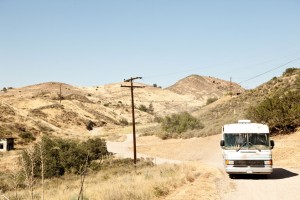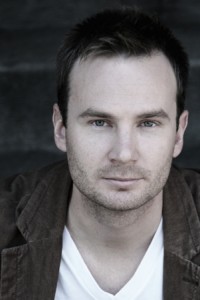Archive for the ‘Interview’ Category
4 Questions with Director, Benjamin Dynice
Here are a few questions and answers pulled from some of the Q&As from various film festivals, with Director Benjamin Dynice.

1. What made you decide to make this movie and why horror?
I was itching to make another project and so I put the word out to my colleagues that I was looking for short scripts. A phenomenal writer and fellow Chapman Alumni Ryan Parrott, with whom I had worked with before on the low-budget action feature film “Loaded,” sent me a few scripts and this one just jumped out at me. I knew I could tell this story, and fortunately, I knew I could make it on a budget, which was somewhat necessary.
I think horror is one of those genres where the story and concept are still king. You can have a great horror film with no names or stars and still manage to get people to see it. Ultimately, I think it’s because people like to be scared, to go outside of their comfort zone.
2. What were some of the biggest challenges you faced making Nowhere Road?
The challenge we faced was the same as most short films…not enough money. The budget is always something that you have to fight against. We ended up pulling in a ton of favors to get this film made and it still cost money. However, I believe the production value of this film far exceeds the budget and for that, I have to thank our amazing cast, crew, and creative team who gave 110% to help make this movie what it is.
During production, we ran up against a multitude of challenges. The first day of shooting was scripted to be our three college kids baking in the sun, but on the day the weather was actually quite overcast with a slight drizzle. We ended up having to cut that setup short and move on to prepare for the rest of the night rather than fighting the weather. We had to come back to that scene three weeks later to do it right in order to capture the feeling of the kids melting in the sun.
3. How was the casting process? How did you get your cast and crew?
Casting is always the most challenging and rewarding. It is like you are having your characters try on different clothes and see them walk around in them, which is great! And can be very satisfying. On the flip side, it can also be like watching really a bad version of your cast as well. It all depends on what type of casting process you get to do. The other thing with casting shorts is that you will likely use certain scenes for the auditions that are part of your movie and I think you have to try and not have those scenes become stale. Sometimes, I have the writer or myself write a scene that would happen in the story but isn’t in our script so that it doesn’t lose its freshness.
4. Are there any plans for this story beyond the short?
Generally speaking, I think that short films that are successful should not be manipulated into a feature, unless that feature version can surpass the short. By that, I mean that it is extremely difficult to take the conflict from a 15 minute film and still make that the central conflict for a 90 minute film. You have to find a way to best it. Well, I think we have done exactly that with our plans for the feature version of the film and we are currently pursuing partners to help bring this film to the big screen.
Have a question of your own? Email us at contact @ nowhereroadthemovie.com and we will send it on to the filmmakers.
SLOIFF Radio Interview
Director/Producer Benjamin Dynice and Producer Austin O’Brien will be on the ‘Talk is Cheap’ radio show with Bill Benica today at 3:30pm in San Luis Obispo promoting the World Premiere of “Nowhere Road”. The show airs on 1340 AM.

The World Premiere screening will be held at 5pm at the Downtown Cinemas in San Luis Obispo, Ca. For more info, check out Screenings.
And check out the festival websites www.sloflimfest.org
Ryan Parrott – The Story of Nowhere Road
Unlike most genres, horror has that rare quality where being absolutely dreadful can sometimes be a blessing. It’s a genre that seems to openly bathe in its clichés, lovingly embrace its stock characters, and bask in its ridiculous debauchery and excess. It can be terrifying, hilarious or even prophetic at times and its ability to bleed and seep into almost every other genre is second to none.
With that in mind, Nowhere Road was an experiment in taking the traditional horror vocabulary and turning it against the audience. The characters, settings, and events depicted are all standard horror movie staples, but it was my hope that the final combination of blood and guts would end up being greater than the sum of its parts. Otherwise, it’s just another bad horror movie… which could be good.
And I love bad horror movies.
Thoughts on the Shoot with DP Michael Roy
 Nowhere Road plays upon the motifs and iconography of some of the most horrific films of the genre; films like Tobe Hooper’s Texas Chainsaw Massacre and Wes Craven’s Last House on the Left. These slasher classics submerged you in a world that was totally unsettling. They felt filthy…decrepit. You could smell the decay as you entered the old Texas plantation house. That’s how I wanted Nowhere Road to feel. I wanted it to feel nauseating.
Nowhere Road plays upon the motifs and iconography of some of the most horrific films of the genre; films like Tobe Hooper’s Texas Chainsaw Massacre and Wes Craven’s Last House on the Left. These slasher classics submerged you in a world that was totally unsettling. They felt filthy…decrepit. You could smell the decay as you entered the old Texas plantation house. That’s how I wanted Nowhere Road to feel. I wanted it to feel nauseating.
I tried to think of what made me most uncomfortable, photographically. I continually found myself returning to old Polaroids from the mid seventy’s. The format doesn’t weather well. The color of these old instant mementos is garish and unflattering- a facsimile of life without truly capturing it. A crisp black and white photograph from the 1950’s can feel totally timeless. Yet, a Polaroid from the 70’s is held hostage, captured by its era. There’s something disquieting about these images. As I stare at the faces of these old photos, I wonder whether these people are still alive. That’s how the photography of Nowhere Road should feel.
The choice to go hand-held was largely a necessity. The confined quarters of the RV allowed very limited mobility. This proved to be a creative asset, as the the location feels stifling, claustrophobic, and utterly inescapable. It forced us to be very nimble with the camera, especially where reflections were concerned. Our camera operator, Andrew Davis, worked absolute miracles in the coffin-like environment. He was continually ready to try shots that I had abandoned as lost causes. The mood of the film owes a great debt to his creative camera work.
The cramped quarters proved equally challenging for grip and lighting. In order to stay agile and free-floating with the camera, our interior lighting had to be minimal… practical. We needed the ability to see everything– floor to ceiling. To meet this challenge we employed single tube Kino Flos and low wattage Soft White practicals. Noah Dille (Additional Photography/ Gaffer) instantly got the feel for our approach. Grip and lighting worked like ninjas, cramming fixtures into the tiniest crevasses, painstakingly shaping the light with the precision of artists. Noah’s lighting was fast, intuitive, and flexible to the frequent demands of our widening frame.
Zach Kramer’s Production Design cemented the look of the project. I was fortunate enough to meet with Zach on at least two occasions during pre-production. Together with Ben, we spoke at length about the “feel” of the environment. Having been brought on late in the game, I hadn’t yet built a “look-book” for the film. I could only hope that my descriptions were sinking in… making sense. I arrived on set to find the RV perfectly matched my mental image. Every detail was there; the wood-laminate paneling, the dirty fishing gear, the remnants of a meal long forgotten. The brother’s environment had to feel completely tangible… and it did.
Throughout the entire process, my primary goal was to provide Director Benjamin Dynice with a photographic environment that was flexible enough to meet his needs… to tell his story. Ben is exceptionally well organized. He entered the project with a keen sense of how he wanted the action staged and how he wanted the image framed. Unfortunately, even the best laid plans encounter obstacles. Ben met these challenges head on. He remained resourceful and adaptive into the the wee hours of the morning (and beyond). At points in the evening when I was exhausted and completely unable to riddle my way out of a photographic puzzle, Ben was clear-headed and ready to make concise decisions. Ben remained calm and rational when others might well have fallen to the chaos.
Nowhere Road was a rare pleasure. I think a very special “thank you” should be given to “the two Nicks” (Nick Huizing- Best Boy Electric and Nick Priess- Set Lighting Technician). These two worked tirelessly the entire shoot. When I was staggering to my car, exhausted and catatonic, “the Nicks” were staring down the barrel of an additional six hours of work. I don’t know how they did it, but I’m tremendously thankful. Additionally, I’d like to thank Morgan Jenkins (Steadicam Operator). Morgan trekked out to a remote, desolate, desert location only to get rained out right before we began to shoot. My hat’s off to the entire crew. Thank you for making Nowhere Road such a rewarding experience.
Thoughts on the Shoot with Austin O’Brien – Producer
 I thoroughly enjoyed this project and I am so excited to see the finished product. With any film there are always an array of obstacles and challenges you are faced with and the trick is make everyone else think that everything is running as smoothly as possible. Needless to say we had a few of our own challenges. From rain on our first day of shooting (in May nonetheless!) to blood pumps with a mind of their own.
I thoroughly enjoyed this project and I am so excited to see the finished product. With any film there are always an array of obstacles and challenges you are faced with and the trick is make everyone else think that everything is running as smoothly as possible. Needless to say we had a few of our own challenges. From rain on our first day of shooting (in May nonetheless!) to blood pumps with a mind of their own.
In an effort to keep our expenses as low as possible, we were able to secure some fantastic locations through personal connections. One of the locations in particular was in Canyon Country, CA. Everything about the location was perfect for what we were looking for, except that in order to get to the location we had to drive 20 minutes (one way) up and down some of the bumpiest dirt roads I have ever experienced while being surrounded by some rather interesting neighbors who were ready to follow through on any of the numerous threats posted on their no trespassing signs if we gave them any reason. Fortunately for us, that never happened.
I think one of the scariest moments for me during the whole shoot was being literally hours away from completing the short on a pick up day and we were still without one of our most important characters: the RV.
In spite of it all, everything always came through and worked in our favor. With the exception of the rain on that first day!!
 Unfortunately I was not able to be on set as much as I would have liked. I was too busy running around putting out fires most of the time. But I do remember one of the scenes I enjoyed most, even if it gave me a heart attack, was when our character “Krin” (Jen Nikolaus) stabs “Chet” (Matt Lasky) in the back. We had a blood rig set to squirt blood when she twists the knife in his back. True to form, blood gags never behave quite the way you expect and the blood explodes out of the pump literally covering the inside of the RV. As much as that was a nightmare to have to clean, the shot looks unbelievable. I don’t think Jen was really ready for it. Everyone outside watching the monitor literally jumped and shouted in shock when it happened. I think it was very effective.
Unfortunately I was not able to be on set as much as I would have liked. I was too busy running around putting out fires most of the time. But I do remember one of the scenes I enjoyed most, even if it gave me a heart attack, was when our character “Krin” (Jen Nikolaus) stabs “Chet” (Matt Lasky) in the back. We had a blood rig set to squirt blood when she twists the knife in his back. True to form, blood gags never behave quite the way you expect and the blood explodes out of the pump literally covering the inside of the RV. As much as that was a nightmare to have to clean, the shot looks unbelievable. I don’t think Jen was really ready for it. Everyone outside watching the monitor literally jumped and shouted in shock when it happened. I think it was very effective.
I think the most fulfilling part of it all for me was watching all the pieces come together and seeing all of the things that Ben and I talked about start to materialize. I believe that it turned out differently than some of us originally imagined, yet so much better than we may have expected. A lot of it was dead on and exactly what we envisioned, but from the casting process to our wrap some things were a little different than we originally imagined, and a little bit better. That’s what I love about the creative process. It’s alive and constantly changing, and as long as you allow room for change then more times than not you may discover things you didn’t even know were there.
I loved working with all of the cast and crew. We had some stellar people who were willing to work with us for peanuts (literally) with a combined passion to make a quality film. Ryan Parrott wrote a great little story for us to work with and I think Ben really brought it to life. Michael Roy had a very clear vision of what he wanted it to look like and I think he did a brilliant job with it. Zach took a tiny budget and made our sets look like a million bucks worth of trashy hillbilly scum, which is exactly what we were going for. Well done to them all!





